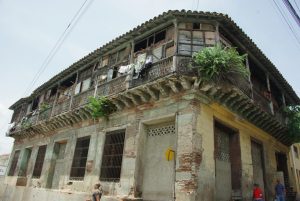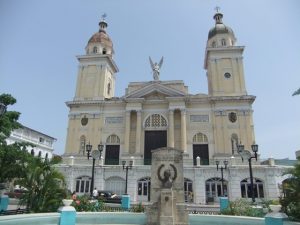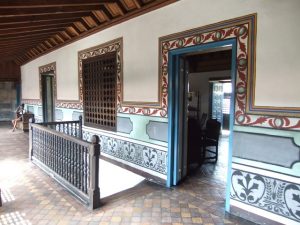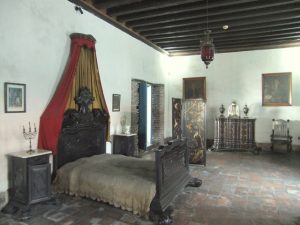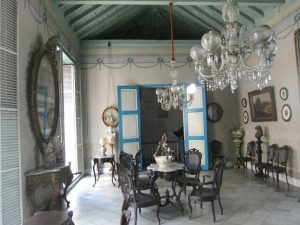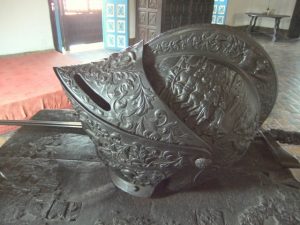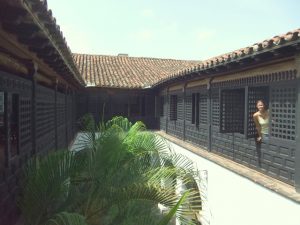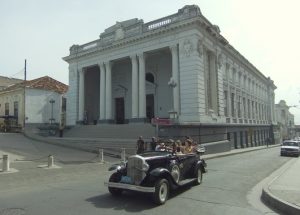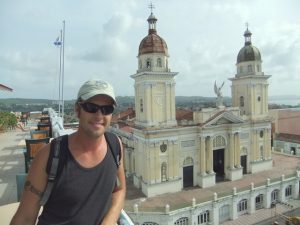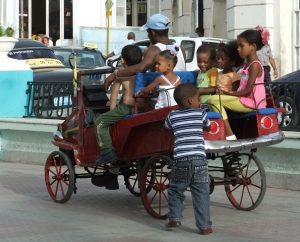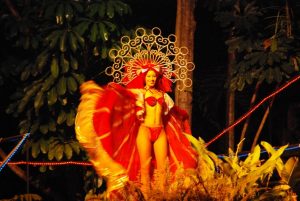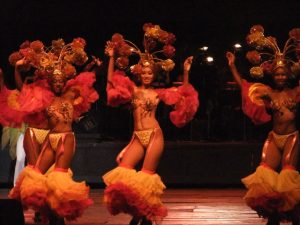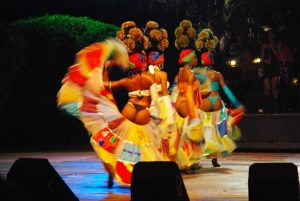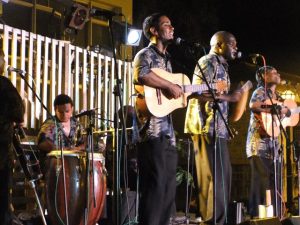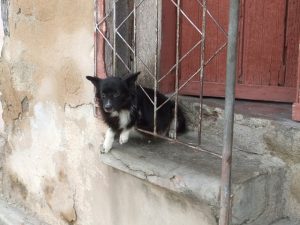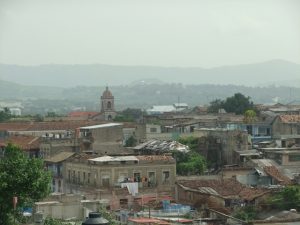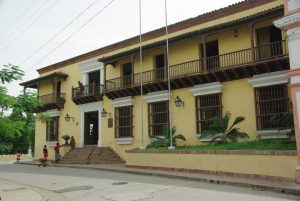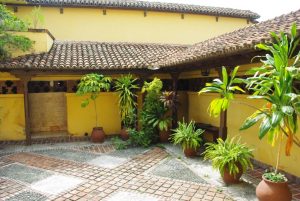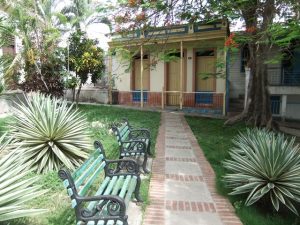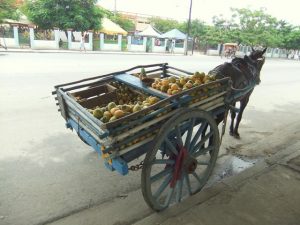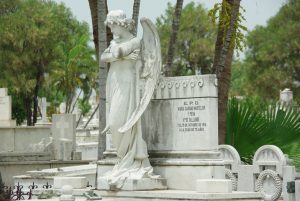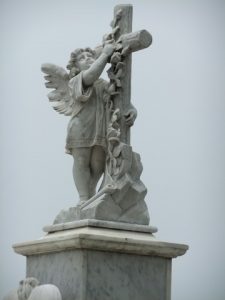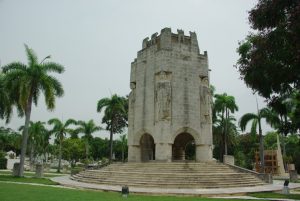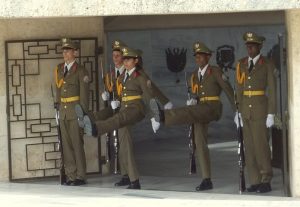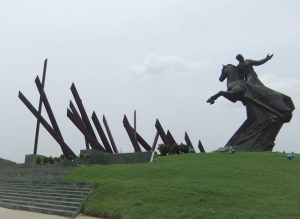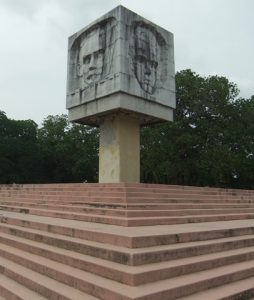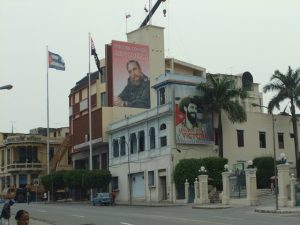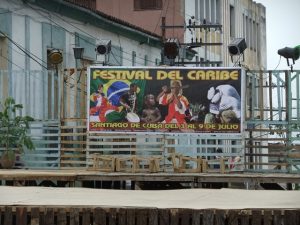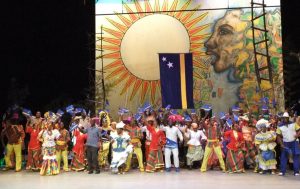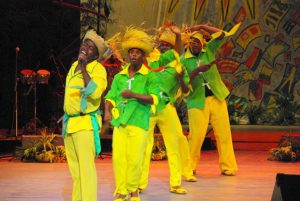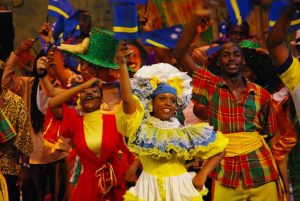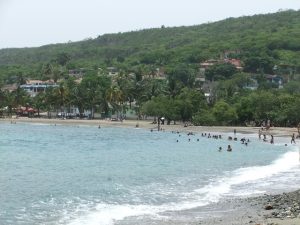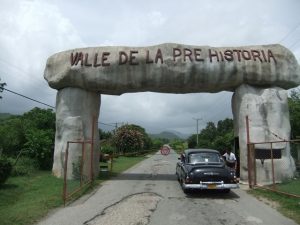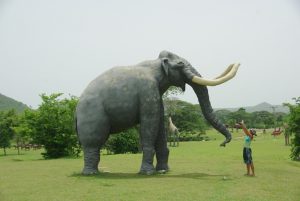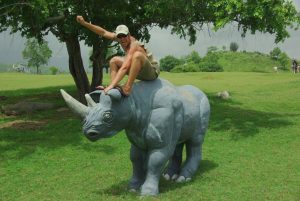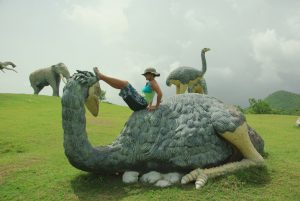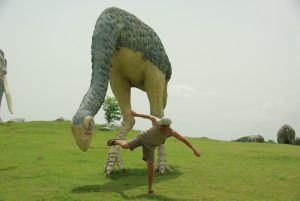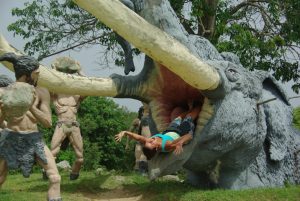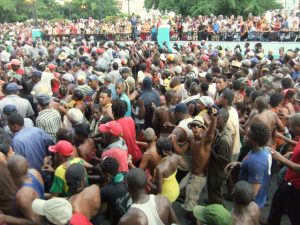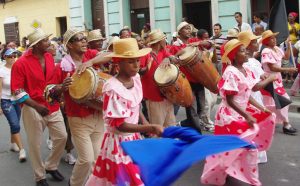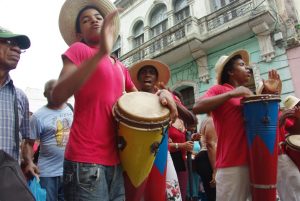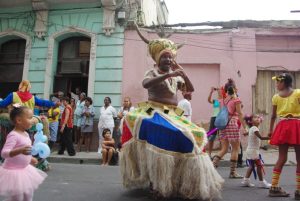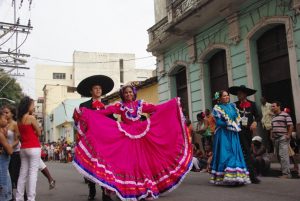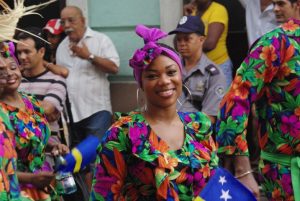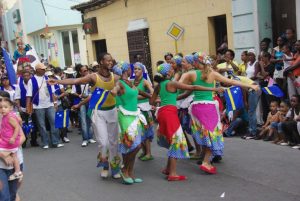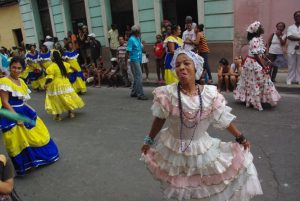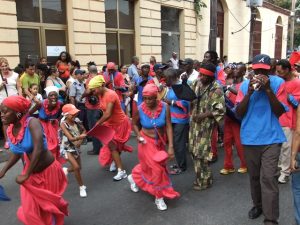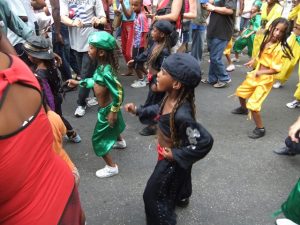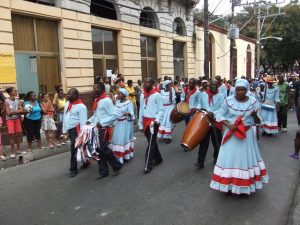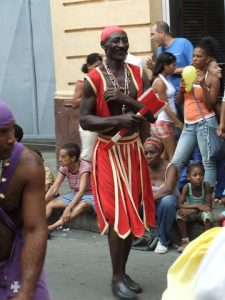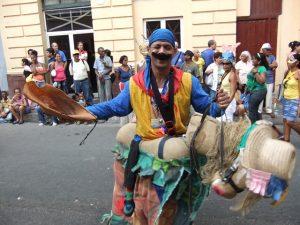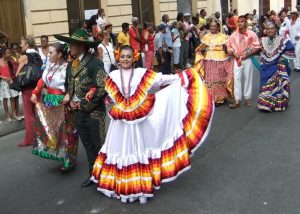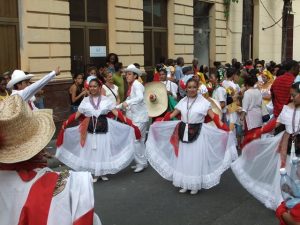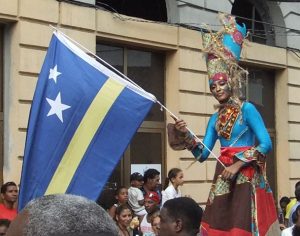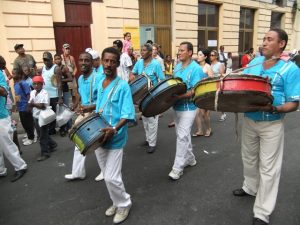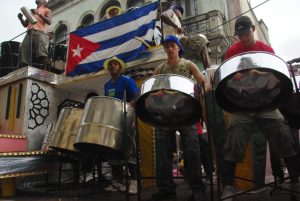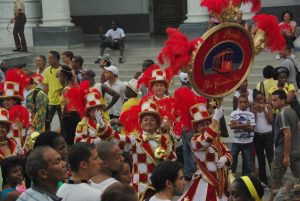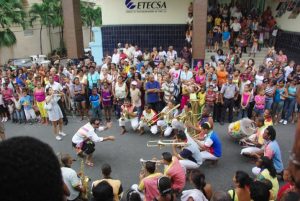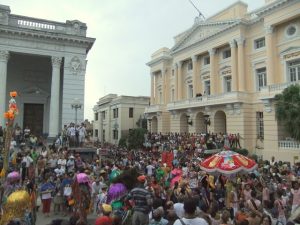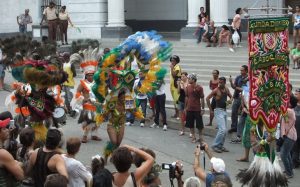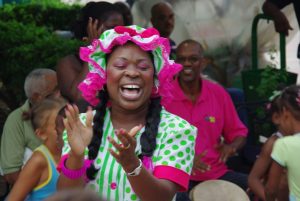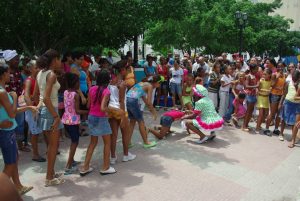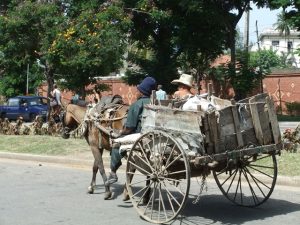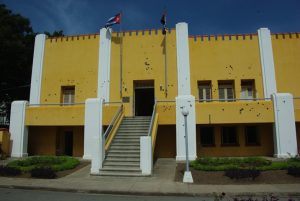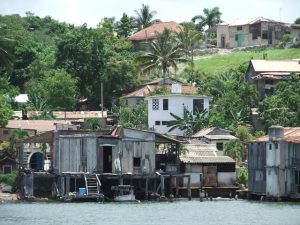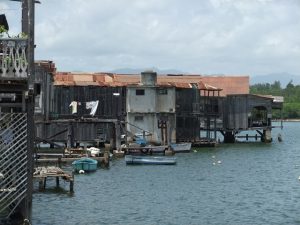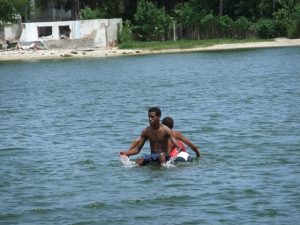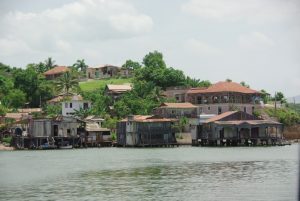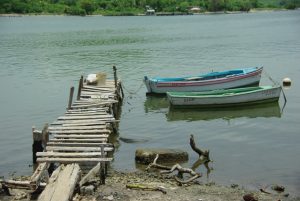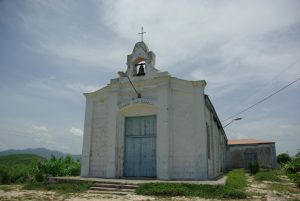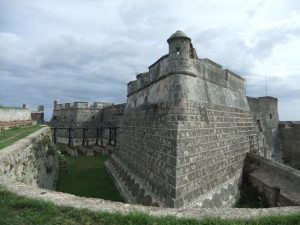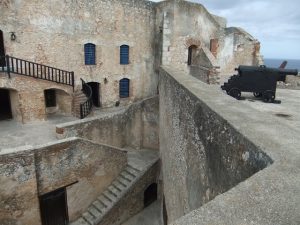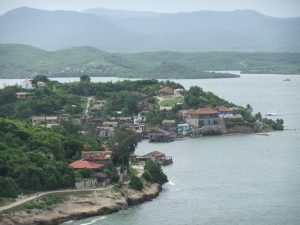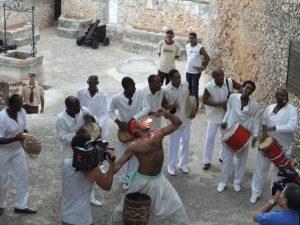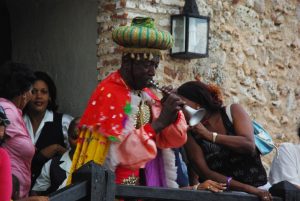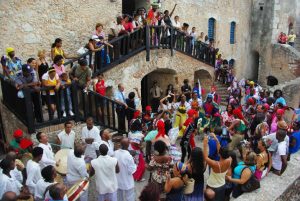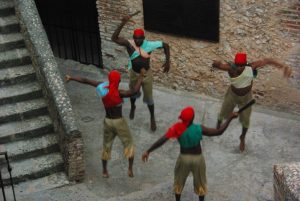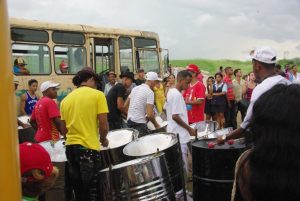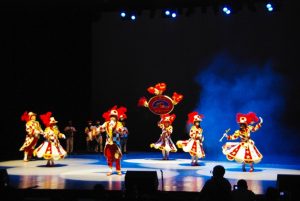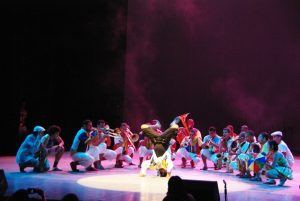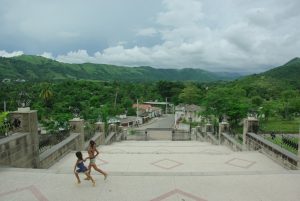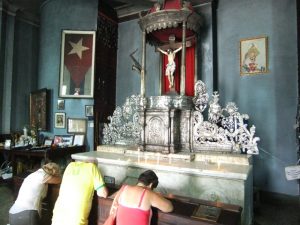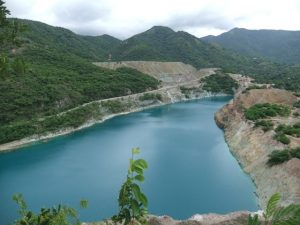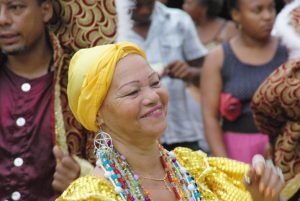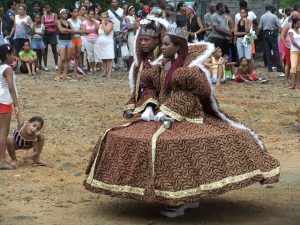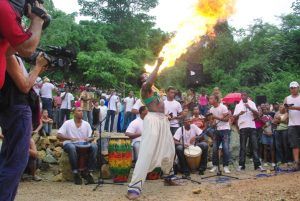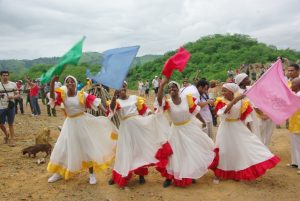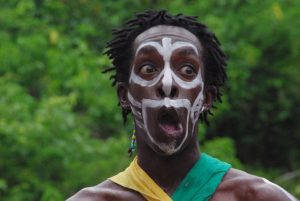Santiago is a happening city, and we were lucky enough to visit during the colorful Fiesta del Fuego (also called Fiesta de Caribe), which is held annually at the beginning of July (3-9 July). To our surprise, it was hard to research the festival prior to our arrival, but once on the ground, we were able to get “participant” passes along with a detailed schedule of festival events showcasing all venues and start times. Lucky for us, some of the festival venues are held throughout Santiago’s surrounds, so we were able to coincide our visits to El Morro and El Cobre’s Loma del Cimarron during the festivities. Overall, we really enjoyed Santiago and our five days here flew by.
3 Jul: Upon arrival at Santiago’s Viazul station around noon, Paco was waiting for us. A 4 CUC taxi ride later, we were near the centro historic, living in a casa just above Padre Pico stairs. We met Paco’s friendly wife Sandra and got settled in. Our room was nice, private with AC and hot water, and costing us 20 CUC a night. After getting settled in, we wandered downtown to explore Day 1 of the Fiesta del Fuego/Fiesta de Caribe Festival. Apparently, this festival has been held for the past thirty years every first week (3-9th) in July, bringing together a bunch of cultural workshops, theater events, and artistic performance to Santiago in a big and free street party atmosphere. The first place we went to was Parque Cespedes, where a stage had been erected for singers and dancers to perform. Our first agenda was to stop by Cubatours to book a Saturday evening excursion to the Tropicana Cabaret, which supposedly is the best show to see during the week. It cost us both 74 CUC, including transportation and a welcome drink. Afterwards, we visited the oldest house in Cuba (Casa de Diego Velazquez) located on Parque Cespedes for 2 CUC each and it was excellent, probably the best preserved house that we have seen in Cuba to date! We did have to be a bit forceful in telling the museum staff that we didn’t require any explanation of anything, and they became a bit sullen but understood once we made it clear no “guide” was required. This museum casa is easily one of Cuba’s best, and definitely deserves a visit. Afterwards, we wandered the streets of Santiago, heading to the Balcon, ruins of an old Spanish Fort with supposedly nice waterfront views. Entrance was free, but it cost 1 CUC to take photos from the balcony. We glanced around and quickly surmised the views, while OK, did not warrant a 1 CUC fee, so we thanked the staff and headed towards some old churches (Iglesia de Nuestra Senora del Carmen and Iglesia de San Francisco) just north of Parque Cespedes, before heading down Santiago’s Saturday only pedestrian street (Jose Saco) which was full of families out and about enjoying the city. We checked out the outside of the Emilio Bacardi Museum (a huge domineering Grecian style building and Cuba’s oldest museum), and briefly visited the Casa de la Musica where Becky joined the band in an impromptu music session. From there, we took the elevator 5 floors up to the rooftop of Hotel Casa Grande, where phenomenal views of Parque Cespedes were to be had, and took photos to our hearts content. Lucky for us, the interior of the Catedral de Nuestra Senora de la Asuncion was open and we decided to pay it a quick visit. A service was ongoing but the murals inside looked really nice. Since we had been running around the city and worked up a bit of a sweat, we decided to cool down with some cheap rum and coke which we started drinking in the park, laughing as Santiago’s numerous touts immediately descended in hordes to pester us. The locals sitting to either side of us appeared to be embarrassed by their fellow countrymen’s attempts to extort money/shampoo/the shirts of our backs from us, as they would shake their heads or openly mock some of the worst offenders. After about an hour or so, we decided to wander Santiago’s streets again, and headed back towards the pedestrian street before looping back to the park. We could see that something was developing from far away, as a huge crowd of people was gathering at the park. Sure enough, the opening ceremonies of Fiesta del Fuego were commencing, as a massive stream of revelers flooded the park, following a makeshift band in earnest, like children after the Pied Piper. We headed back to our casa for a lobster dinner, followed by a show at Tropicana. The show was good with a fabulous variety of costumes, although some of the dancers have seen better days. We hung out briefly at Parque Cespedes after the show until a performer started openly flirting with Robby and we decided to call it a night, crashing at about 1 am.
4 Jul, Santiago de Cuba: This morning we decided to follow our Chris Baker’s Cuba Moon travel guide’s “Revolutionary walk” tour, first visiting “Museo de la Lucha Clandestina”, which details the underground struggle against Batista with displays entirely in Spanish, and no photography allowed. Opposite the museum is a tiny house that Fidel Castro lived in for a brief amount of time while in Santiago, and we kept zig zagging back and forth through the city until we eventually made our way to the Cementerio De Santa Ifigenia (1 CUC) and the Mausoleum of Jose Marti. The cemetery had numerous 26 July grave markers, with bright red and black flags marking the revolutionaries grave sites. The most important thing at the cemetery was the small military ceremony carried out by proud young soldiers at the Marti Mausoleum every 30 minutes. They were led by a female soldier who smartly marched them over to the mausoleum in a “changing of the guard”. We were feeling pretty energetic so we opted to hike onward to the Revolutionary Plaza where we bought our Viazul tickets for next Thursday towards Baracoa for 15 CUC each. Parched for water, we went to the restaurant next door to Viazul where the waitress immediately pointed to our shirts and said that no tank tops were allowed inside. We settled for her bringing bottles of water to us, but it was a comedy of errors, with her first bringing tiny bottles of water instead of the 1.5L we asked for, followed by her bringing out a 1.5L bottle of TuKola instead of water, and then with her telling us there were no 1.5L bottles of water. At this point, we asked for our money back when miraculously, the large bottles of water appeared as if a mirage, while our waitress slyly pocketed an extra CUC for her efforts. We later found out we could have had a much more pleasant and simpler experience if we had just made a stop at any one of the gas stations where there were plenty of 1.5 L bottles of cold water to be had. Since we were already at the Plaza de la Revolucion, we walked up to inspect the massive statue of General Maceo on horseback surrounded by 23 stylized machetes, which is located next to the Viazul bus station along Avenida de Los Libertadores. It is a huge structure but it was hard for us to get a decent photo that put its size into perspective. We noticed the large Heredia Theater across the street, and Becky remembered reading that last night’s Fiesta del Fuego festivities had been held there, so we decided to stop by to get more information about the festival. A very entrepreneurial lady stated that today was the cut off to purchase VIP passes, granting us access to all the activities along with a corresponding schedule of events. We tried getting the information for free and even mentioned that the street parade was free, so why should we pay for passes when she explained that there were several cultural workshops and events held at the Heredia Theater, and without the passes we wouldn’t be able to gain entrance. She then quickly told us the passes cost 50 CUC each (originally 75 CUC) and we laughed along with her, telling her there was absolutely no way we could afford to pay that kind of money. Once she smiled in response and told us that she was sure we could work something out, we knew that we’d be able to work out a deal. In the end, we settled and agreed on 10 CUC for entrance to all events, and since it was all under the table with the proceeds going directly to the lady selling us the passes, it was win-win for everybody. The other ladies at the ticket booth looked like fellow co-conspirators as they furtively looked around for change when we gave them a 50 CUC note. Armed with a list of Fiesta de Caribe events, we decided that we’d head back to the casa for dinner (fried fish), and return back to the theater for tonight’s Curacao performance at 9 pm. Since it took us about 30 minutes to leisurely walk back, we opted to catch a 3 CUC taxi ride to the theater, and enjoyed the show put on by Curacao’s entertainers for well over an hour. Since we were in no rush after the show, we strolled back on Santiago’s deserted streets to the heart of the city, stopping by the packed Parque Cespedes to check out the entertainment put on at midnight. To our surprise, couples were out dancing and the area was crowded with revelers. We called it a night after deciding that a night of dancing wasn’t in our cards.
5 Jul, Santiago de Cuba, Playa Siboney: Sandra had proudly created an American style breakfast for us, a la grilled ham and cheese. It was actually quite tasty, making for an interesting and fulfilling meal. Our plan today was pretty chill, with our only intention to relax at a nearby beach, Playa Siboney, and catch the opening parade for the Fiesta del Fuego later that afternoon. We were a bit early to meet our prearranged taxi at our agreed upon meeting point at 0930, but after waiting almost 15 minutes after he was supposed to meet us, we ended up going with another cabbie who was fastidiously rubbing down his vintage automobile with a lot of TLC. He agreed to the same price of 25 CUC round trip including wait time. Playa Siboney was quite the pleasant day trip from Santiago, with lots of shady trees and a beautiful soft sand black beach. We agreed to four hours of bliss here, before linking back up with our driver at 2 pm to head towards a prehistoric park (Valle de la Pre Historia) that he suggested as an extra excursion. Cubans started flocking to Siboney later in the day, and soon loud music was booming from a nearby stand, making for an interesting beach experience. We dipped into the clear waters to cool off, and found the shady trees a perfect retreat from the beating sun. Four hours here zoomed by, and we were off to the prehistoric park, which was actually quite hilarious. Massive concrete sculptures of dinosaurs, woolly mammoths, rhinos, and a myriad of other interesting characters were spread over several acres of pristine land. We later found out that prisoners from a nearby prison had worked on these figurines, and it was definitely a bizarre visit. We were back in Santiago by 4 pm and dropped our bags off at the casa before rushing back out to get to the start of the “Parade of the Serpents”, this year’s theme for the opening parade of Fiesta del Fuego. The parade actually kicked off closer to 6 pm, and we watched as thousands of participants clad in their respective countries traditional outfits marched down the street, starting at Plaza Dolores and culminating at Parque Cespedes. We met so many lovely performers and were quite surprised when several of them invited us to their respective after-parties at several of the clubs in town. It was a fun, festive and colorful affair, and we took countless photos before the finale. Since Sandra had prepared chicken for dinner, we headed back to our casa and stuffed ourselves silly. Another great day in Santiago!
6 Jul, Santiago de Cuba, El Morro: After breakfast, (Sandra was sick so Paco cooked a wonderful meal for us….we told him we wouldn’t have time for dinner tonight as we were on the go, go, go), we headed over to Santiago’s most famous museum, the Cuartel Moncada (entry 2 CUC plus 1 CUC for camera). This famous building was stormed on 26 July, 1953 by Fidel Castro and his men. The assault failed disastrously, but became the first act of the Cuban Revolution. The exterior of the building still has bullet hole marks (although they are not the original…Batista ordered the originals filled in and Castro had them recreated). We were able to see a scale model of the barracks and surrounding buildings circa 1953, lots of weaponry, and were horrified to see the graphic torture images of what Batista’s men did to the captured revolutionaries. It was interesting, but we disagreed with our guide book’s write up that this is “the best museum in Cuba”. We had some time to kill before our noon meeting time with our ride, so we stopped by the colorful Museum of Carnival (our participant passes saved us on entry fees), and checked out the costumes, instruments, posters, and photos of yesteryear’s Carnivals. Carnival is HUGE in Santiago and we wistfully wished we could be here at the end of July to partake. We met our taxi driver at noon and headed towards Cayo Granma, a small island that sits about 1 KM offshore from El Morro. It is a small fishermen’s colony, which looks quite scenic and quaint in the middle of the bay. We caught a ferry where the locals paid only 20 centavos but we were forced to pay 1 CUC each (rip off), for the short journey to the island. We quickly found out that the island is miniscule, and we walked around it in a leisurely 20 minutes, hiking to the highest point of the island to visit the Iglesia de San Rafael which was closed. While waiting for a return ferry back towards El Morro, we were lucky enough to catch alternative transport back at the cost of only 1 peso each national moneda. From the ferry drop off, we walked towards El Morro, with a brief (and late) lunch stop at Playa La Estrella, where a beggar immediately accosted us for money because he was “hungry”, but we offered him food instead. He didn’t like any of the food we offered, but did take our Oreo cookies, before starting again on us giving him money for a drink. We flatly refused to give him money as we didn’t want to encourage begging, and he finally thanked us for the snacks and left us alone. The walk up towards San Pedro de la Roca Fortress (El Morro Castle) was a bit steep and we were both drenched in sweat from our brief exertions. The El Castillo del Morro was built in 1633 and is set high on a 60 meter promontory, with fine 360 degree views. It is a UNESCO World Heritage site, and we quickly found out that the breeze up there was magnificent, drying off our sweat in mere minutes. There were several performers already at the castle in costume, gearing up for their 1800 ceremony. The El Morro castle is quite scenic, with lots of canons and beautiful views overlooking the harbor. An entrepreneur was selling coke, beer and water for 1 CUC each, so we bought a few drinks and watched the festivities, meeting an interesting America/Cuban musician who worked for several years touring with Barry Manilow around the world. He was really into the music and explained a bit of the history for us…very fascinating individual! The performance was colorful, engaging but a bit short. We enjoyed all of it, and followed the dancers as they exited from El Morro over to an impromptu parking lot, where a Brazilian band was putting on a show. The evening cononazo ceremony kicked off at around 1830, so we headed back into the fort to witness the colonial garbed soldiers load and torch a canon at sunset, only to have it fizzle short. What a pity…the Cubans watching the event made fun of the soldiers (apparently the evening before the same thing happened), but the views at sunset were lovely. To our immense relief, our taxi driver was patiently awaiting us in the parking lot where he had promised to be waiting for us (we had prepaid earlier in the day and were reluctant to do so as we had no guarantee that he would show up but he wanted payment to guarantee he wouldn’t give his business to someone else or have us ditch him on the return ride with another cabbie!) We were so glad to see him, and headed back into town after quickly changing out of our outfits into some cleaner (and less sweaty) clothes. Our destination was the Teatro Heredia where the Brazilian contingent from Pernambuco were performing, and what a great performance! They wowed the crowd with the variety and complexity of their performances, and amazing costumes. Excellent, but it was annoying having to contend with folks standing up at the base of the stage trying to video tape the entire performance with their amateur cameras. Leave that to the pros, people! We walked back and were in our casa just before midnight, where we talked briefly to Paco and Sandra before taking nice cold showers to cool down and get some of the sweat of us. Great day.
7 Jul, Santiago de Cuba, El Cobre: We woke up and had no major plans today except to visit the Emilio Bacardi Museum and El Cobre. So we slept in till 9 am, and enjoyed a late leisurely breakfast on Sandra and Paco’s patio. After breakfast, we relaxed until about 1 pm, and talked briefly to Sandra’s friend on what time we wanted dinner (1930) and what we wanted to eat (shrimp) since both Sandra and Paco were out and about. After four busy days in Santiago, we had finally realized that we were making an extra loop each time we headed towards Parque Cespedes, and cut out the extra hill climbing by taking a more direct route (and bypassing the Padre Pico staircase). The Emilio Bacardi museum was a bit cluttered and no photos are allowed. The bottom floor has a rather oddball assortment of exhibits (weaponry, shrunken heads, Peruvian skeletons and pottery), while the upstairs serves as a gallery for an eclectic range of artwork. Afterwards, we met our taxi ride and found out that our go to guy had to get his car repaired, so he handed us off to his “cousin” who would take us to El Cobre for the same price we had agreed to the day before (25 CUC including wait time for the festival). We dutifully piled into the yellow, decrepit Lada at 1500 and visited the Basilica del Cobre first. It is located about 12 miles from Santiago. The region of El Cobre was once famous for its copper (hence the name “Cobre”). The basilica is famous for housing the statue of the Black Virgin, declared the Protectress of Cuba since 1916. Visitors can gain access to the diminutive but highly revered statue by entering from the rear of the Cathedral and climbing a staircase to a viewing area. We saw lots of locals bringing flowers to lay at the viewing area before the Virgin Statue, praying in silence in the pews before her. We found out that Pope John Paul II visited here in 1998 and blessed the Black Virgin. She is dressed in yellow and wears a gold crown encrusted with diamonds, emeralds and rubies. It didn’t take long to visit this complex, and afterwards, we drove to the old mines of El Cobre where the slaves were forced to work at a place called “Loma del Cimarron”. Lucky for us, tonight as part of the Festival del Fuego, there was a religious themed show to pay tribute to the slave rebellion at the Loma del Cimarron Monumental Complex. Our fiesta schedule indicated the performance was supposed to start at 1600, but as 1700 rolled around, we realized that it would actually be closer to 1800 when the festivities would kick off. We were only able to catch about an hour of the show, but it was well worth attending, with lots of colorful costumes, dance and songs in such a historically significant location. It started pouring down with heavy rain on our ride back to Santiago, and we were happy that our cabbie offered to drop us off at the casa (he had slyly offered to take us to the Viazul bus station at 0700 sharp for 5 CUCs). He wanted to do a recon to figure out where we were staying and it worked out well for us, as we would have gotten a severe drenching if we had done the usual walk back from Parque Cespedes. Our shrimp dinner was excellent…boy can Sandra prepare a mean dish! We are going to miss her good old fashioned cooking, and definitely enjoyed our casa in Santiago.
8 Jul, Thurs, Santiago de Cuba – Baracoa (0745 departure, arrival to Baracoa by 1230 ish): Got up early for one of Sandra and Paco’s last breakfasts before our taxi ride to Viazul (5 CUC). It was chaos in the terminal, and we had to wait for the inefficient baggage handler who was more concerned about earning his propina (tip) than in actually getting bags to their respective owners! When it was finally our turn to turn in our bags, he pointed to the tip kitty before pulling out the baggage tags labeling our bags for Baracoa.


